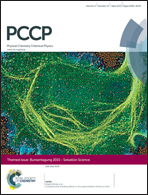Water structure and chaotropicity: their uses, abuses and biological implications
Abstract
The concept of “water structure” has been invoked to explain all manner of aqueous phenomena. Here we look at the origins of this tendency to understand solute hydration in terms of structural changes in bulk water, and consider the validity of one particular example: the classification of small solutes as chaotropic or kosmotropic, and the putative relation of this terminology to notions of structure-making and structure-breaking in the solvent. We doubt whether complex phenomena such as Hofmeister and osmolyte effects on macromolecules can be understood simply on the basis of a change in solvent structure. Rather, we argue that chaotropicity, if understood in the original sense, arises from the activities that solutes exert on macromolecular systems, as well as from deviations of solvation water from bulk-like behaviour. If applied judiciously, chaotropicity remains a potent, biologically pertinent parameter useful for classifying and understanding solution phenomena in all types of living system.

- This article is part of the themed collection: Bunsentagung 2015: Solvation Science

 Please wait while we load your content...
Please wait while we load your content...